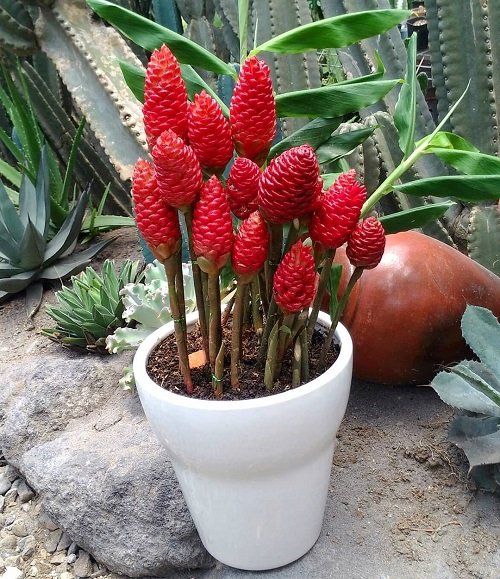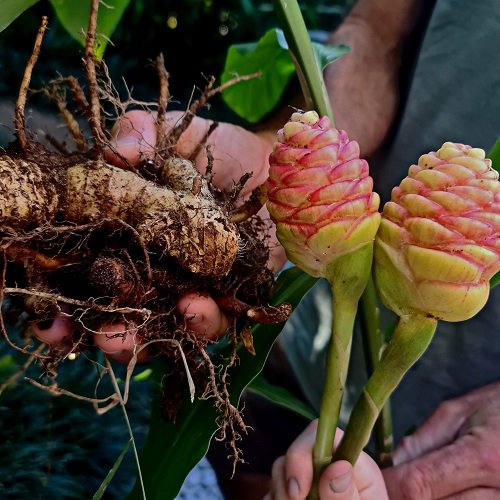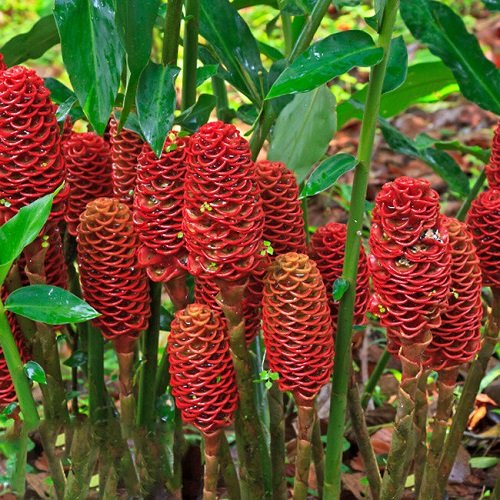Shampoo Ginger Lily is a quirky yet attractive plant with standout looks! Here’s everything you need to know about growing it!

If you want a different yet vivid plant to add to your collection, then look no further than Shampoo Ginger Lily! Let’s dive into its growing details!
Shampoo Ginger Lily Plant Information
Shampoo Ginger, or Pinecone Ginger, is native to tropical Asia, including India, Indonesia, and the Malaysian peninsula. Due to its ornamental and practical value, the plant has been introduced to various tropical and subtropical regions around the world.
- Growth Habit: Shampoo Ginger is a perennial that can grow up to 6 feet tall, with long stems and lance-like leaves reminiscent of bamboo.
- Flowers: The inflorescences of the Shampoo Ginger are particularly distinctive. They emerge at the base of the plant and resemble upright pinecones. These inflorescences start out green and then turn a bright, reddish-pink as they mature. Small, fragrant yellow flowers emerge from the bracts of this “pinecone.”
One of the most notable uses of this plant is as a natural shampoo. When mature, it exudes a clear, slimy, fragrant liquid. This liquid has uses in several cultures, especially in Asia, as a shampoo or hair conditioner.
Beyond its use in hair care, various parts of the plant have been employed in traditional medicine in its native regions. For instance, in some cultures, the rhizomes are used to treat inflammation, pain, and a variety of other ailments.
USDA Zones: 8-11
Propagating Shampoo Ginger Lily Plant

Shampoo Ginger Lily plants can be grown from roots and seeds. The most favored method is via rhizomes.
- Use a thick, juicy clump of Shampoo Ginger Lily with many buds.
- Take a sharp knife, wear gloves, and cut the rhizomes into pieces with many buds. Keep them for some days until the cuts dry.
- Fill a bowl with warm water and soak the rhizome pieces overnight.
- Take a large pot, fill it with potting soil, and compost.
- Now, plant a couple of pieces half-inch deep in the soil with buds facing upwards.
- Place the pot in a warm, sheltered area with filtered light.
- Keep the container in full sun if you live in a cold region.
- Water the plant when the topsoil feels dry to the touch.
- Apply organic fertilizer twice a week until rhizomes sprout.
Requirements for Growing Shampoo Ginger Lily

Location
It grows best in partial shade or full sun. In extremely hot areas, it’s best to give the plant some afternoon shade to protect it from scorching.
If you’re growing it indoors, placing it near a window with bright, indirect light works well. A south-facing window with some shading or filtering is often ideal.
Soil
Use well-draining soil as this plant doesn’t like to sit in waterlogged soil. You can use a mix designed for tropical plants or amend garden soil with organic matter and some sand to improve drainage.
The pH has to be neutral, slightly acidic, or slightly alkaline soil.
Watering
Water Shampoo Ginger Lily when the top inch of soil feels dry. It’s essential not to overwater, as this can lead to root rot. Be particularly cautious about overwatering if you’re growing the plant indoors.
Temperature and Humidity
- Outdoor Growth: Ideally, temperatures should remain between 60°F and 85°F (15°C – 29°C) for optimum growth. The plant can tolerate temperatures as low as 50°F (10°C) but should be protected from frost. If you’re growing it in an area where temperatures drop below this range, consider planting in pots so you can bring them indoors during colder months.
- Indoor Growth: If you’re growing the Shampoo Ginger Lily indoors, maintain a consistent temperature, avoiding cold drafts.
Shampoo Ginger Lily prefers high humidity. If you’re growing it indoors and your home is dry, consider placing a humidifier nearby or placing the pot on a tray filled with water and pebbles (the water should not touch the base of the pot).
Shampoo Ginger Plant Care

Fertilizer
A balanced, slow-release granular fertilizer with an N-P-K ratio close to 14-14-14 or 10-10-10 is generally suitable. If you’re using liquid fertilizer, make sure to dilute it according to the instructions on the label.
Apply the fertilizer at the beginning of the growing season (spring) and then again in mid-summer. Follow the label’s recommendations on quantities.
Note: Over-fertilization can be more harmful than under-fertilization. Yellowing leaves may be a sign of over-fertilization. Always water the plant after applying granular fertilizer to help distribute the nutrients and prevent root burn.
Pests and Diseases
The Shampoo Ginger Lily, while relatively robust, can fall victim to a few pests and diseases. Among the most common pests are spider mites, which are especially problematic for indoor specimens.
Aphids, which are small and can range in color from green to black, are another sap-sucking insect that can attack the Shampoo Ginger Lily.
Mealybugs, easily identifiable by their white, cottony appearance, can be found on the undersides of leaves or in leaf axils, also causing damage by sucking sap from the plant.
On the disease front, root rot can emerge if Shampoo Ginger Lily is overwatered or if it’s grown in poorly draining soil. This malady manifests as brown, mushy roots and might be accompanied by wilting or yellowing leaves.
Fungal infections can also plague the plant, leading to issues such as leaf spot – characterized by discolored spots on the leaves – and rust, which appears as orange or reddish-brown pustules typically on the leaf undersides.
Ensuring good air circulation and refraining from overhead watering can mitigate the risk of these fungal diseases.
Zingiber Zerumbet Uses
- The main use of the plant, for which it gets its name, is as shampoo. The mature flower heads or cones exude a clear, slimy, and fragrant gel that’s perfect for hair care.
- It makes a lovely floral arrangement in cut flowers and as an ornamental plant.
- The red pinecone ginger is also popular as a landscape plant due to its bright green leaves and red cone-like inflorescences.
- Shampoo ginger lily plant is used for traditional medicines, free radical generation, cancer cell proliferation, and protein production.
- It is also famous for its anti-inflammatory properties.
- The plant has antidiabetic, antioxidant, analgesic, antimicrobial, antiviral, and anticancer qualities.
Shampoo Ginger Lily Where to Buy
Shampoo Ginger (Zingiber zerumbet) can be sourced from several places:
- Local Nurseries: Check with nurseries or garden centers that specialize in tropical or exotic plants. Given the plant’s ornamental appeal, many such nurseries carry Shampoo Ginger, especially in states with milder climates like Florida, Hawaii, or California.
- Online Retailers: Numerous online plant retailers and specialty nurseries offer Shampoo Ginger for sale. Websites like Etsy, eBay, and Amazon often have individual sellers or nurseries that list such plants. However, when buying from these platforms, always check the seller’s reviews and ratings.
- Specialized Plant Catalogs: There are many mail-order nurseries that specialize in tropical plants. A quick online search for “Shampoo Ginger plants for sale” or “tropical plant mail-order nurseries” should provide a list of potential vendors.
- Plant Swaps or Local Plant Groups: Join local gardening groups, botanical societies, or plant swap events. Fellow enthusiasts might have Shampoo Ginger plants or rhizomes to trade or sell.
- Botanical Gardens: Some botanical gardens have plant sales or gift shops where they offer unique or tropical plants. They might carry Shampoo Ginger or be able to direct you to a reliable source.


